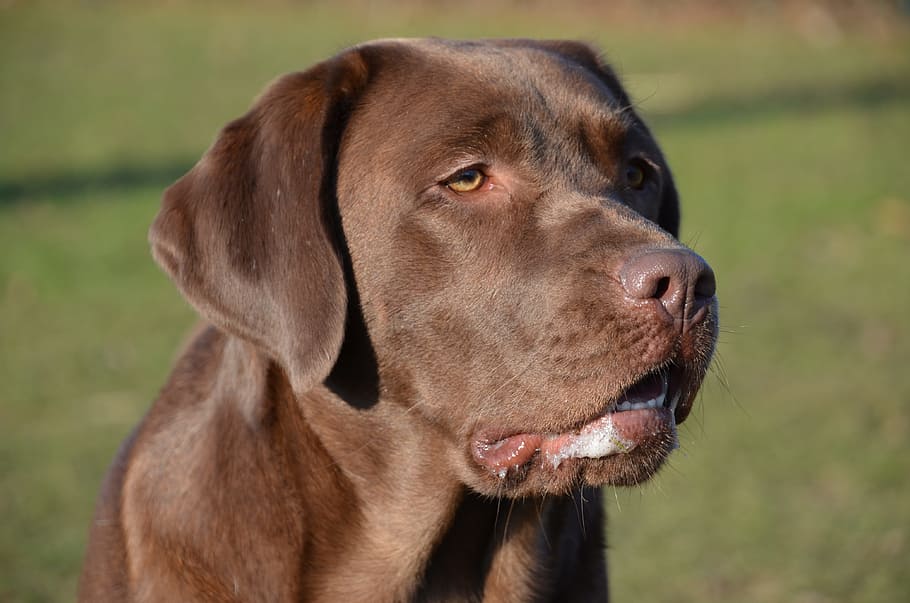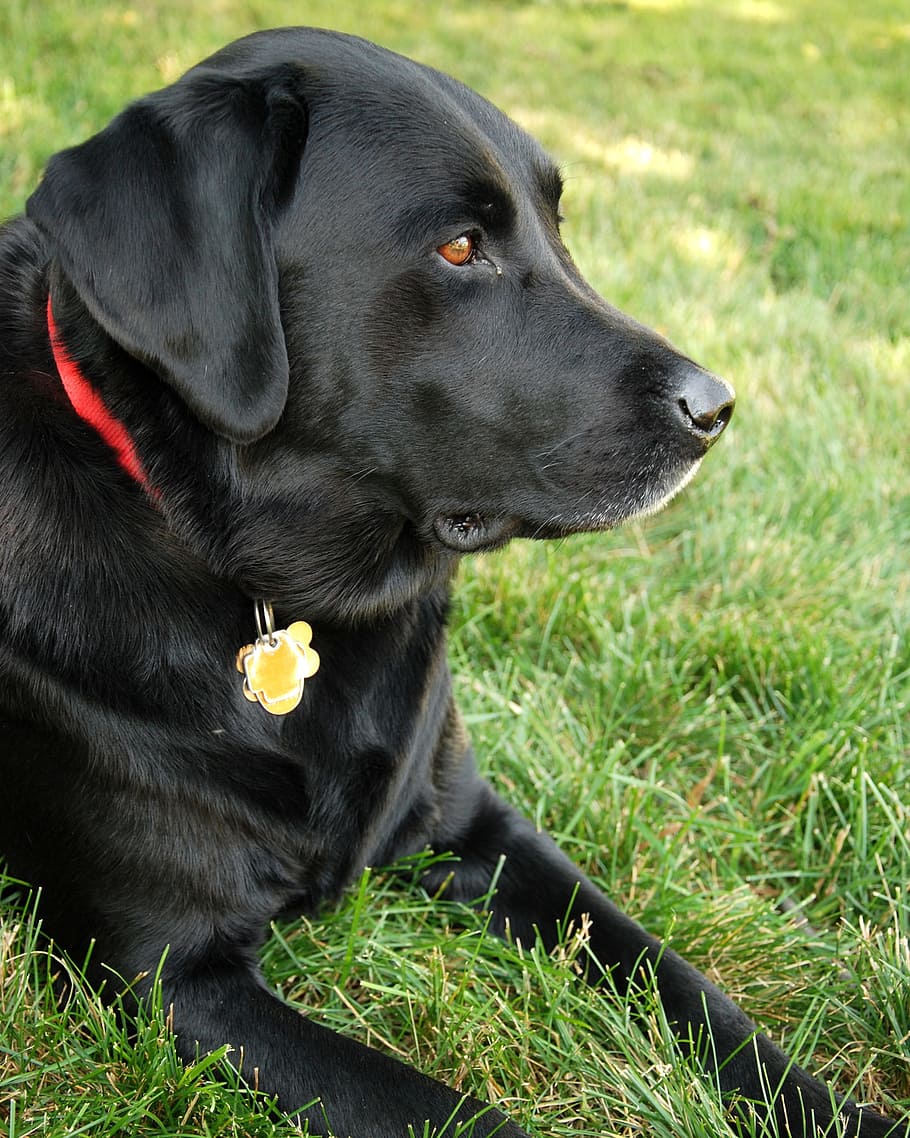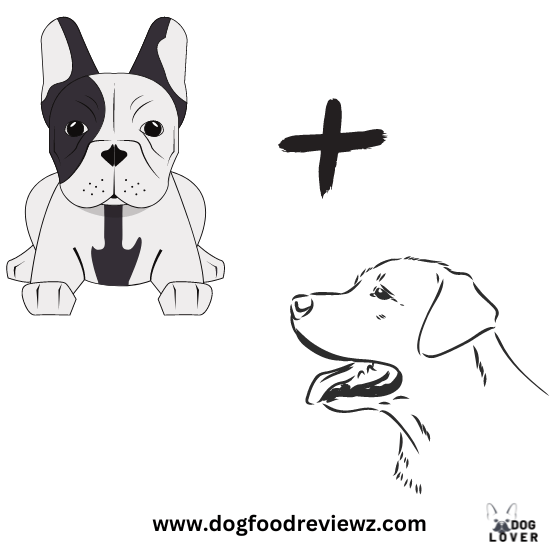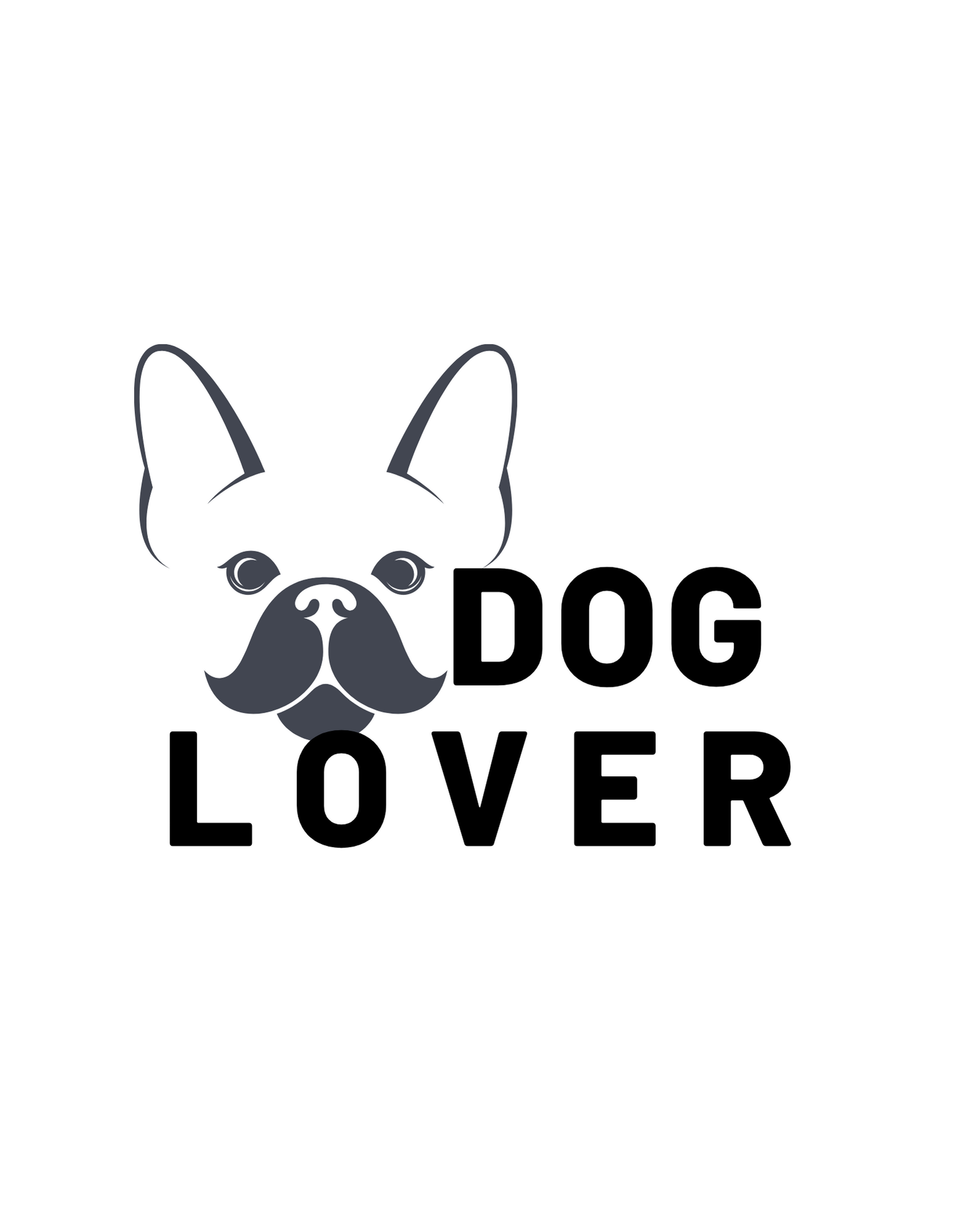Have you met the cheerful and charming French Bulldog and Labrador mix yet?
Come with us as we explore more on this designer dog to help determine if it’s the dog you have been looking for.
Let’s get straight to it.

Breed Overview
A Frenchie Lab is a sweet, smart, loving medium-sized dog that makes a great family pet. It’s a highly playful, delightful, and sociable pup full of natural love for people. The table below gives a quick summary of this hybrid dog:
| Character | French Bullabrador |
| Other names | Frenchie labrador, Labra-Frenchie, French Lab, or Bullador. |
| Dog breed group | Mixed breed |
| Purpose | Companionship |
| AKC Recognition | No |
| Size | Medium-sized |
| Height | 16-18 inches |
| Weight | 35-50 pounds |
| Coat type | Short, smooth, and dense |
| Coat color | Cream, white, fawn, black, brindle, chocolate,or yellow |
| Temperament | Social, loyal, affectionate, friendly, playful, calm, and cheerful |
| Grooming needs | Low |
| Trainability | High |
| Exercise needs | 30-60 minutes daily |
| Child friendliness | High |
| Dog friendliness | High |
| Health | Relatively good |
| Lifespan | 9-15 years |
| Puppy cost | $1,500-$5,000 |
What is a French Bullabrador?
A French Bullabrador, otherwise known as a Frenchie lab, bullador, Frenchie labrador mix, or labra-Frenchie, is a hybrid dog that results from the crossbreeding of a French Bulldog and a Labrador Retriever. This mix produces a medium-sized dog with a friendly and sociable nature.
Parent Breeds
While the exact origins of a Frenchie lab remain largely unknown, its parents have a rich history. The French Bullabrador is a mix of a French Bulldog and a Labrador retriever. This hybrid dog was created to bring out the best of Frenchies and Labradors.
To understand the kind of dog a Frenchie Lab is, it’s important to learn about its parents.
French Bulldog
- The Frenchie has its origin in England in the late 1800s.
- The French Bulldog is a descendant of the English Bulldog, initially bred for bullbaiting.
- English breeders later bred down the English Bulldogs to a smaller size when bullbaiting was banned.
- These smaller bulldogs were famous among the lacemakers living in Nottingham and were considered a mascot for them.
- The bulldogs first appeared in France in the mid-19th century when the lacemakers moved from Nottingham and settled in Normandy, France, following the industrial revolution and brought their little dogs along.
- In France, the toy bulldogs were crossed with Parisian ratters to create the French Bulldog we know today.
- The French Bulldog was recognized by the American Kennel Club in 1898.
- In 2020, French Bulldogs were ranked by the AKC as the 4th most popular dog breed in the US.
- The Frenchie is a small, stocky, muscular dog described as playful, affectionate, smart, and highly adaptable.
Labrador

- The Labrador retrievers originated in Newfoundland, Canada, and are part of the Newfoundland breed.
- Labs were known for their swimming and retrieving things like fishnets and prey.
- Due to high dog taxes, the population of Labrador retrievers diminished in Newfoundland.
- However, their population boomed in the UK following massive importations in the early 1800s.
- Labrador Retrievers were brought to North America in the late 1900s and have grown to become among the most popular breeds in the US.
- Labrador retrievers received AKC recognition in 1917.
French Bullabrador
- The exact date of origin of the French Bullabrador is not known.
- However, you can expect a Frenchie Lab to be an extremely friendly and social dog, just like its parents.
- It’s difficult to tell exactly how a Frenchie Lab will turn out as its characteristics depend on the parent it takes most after.
- This designer dog combines the best features of both French Bulldogs and Labradors.

Appearance
A Frenchie Lab has the facial structures of a French Bulldog with a square-shaped head, short muzzle, round forehead, and big dark eyes. It can have bat-like ears, like its Frenchie parent, or semi-pricked ears that sit high on the head.
A Bullabrador has the shape and structure of a Labrador retriever. It has a muscular, sturdy frame with short legs and a distinctive tail.
Lab and Frenchie mix size, height, and weight
A lab and Frenchie mix is a medium-sized dog with a sturdy and athletic build. A fully grown Frenchie lab stands between 16-18 inches tall and weighs 35-50 lbs. There is a slight size difference between males and females Bullabrador, with males slightly bigger.
Lab Bulldogs mix coat colors and types.
Like its parents, a Lab Bulldog has a short, smooth coat with medium-length hair. The coat is dense and straight and comes in various colors, including cream, white, black, fawn, brindle, or a combination.
Temperament
Being a cross between the two friendliest dog breeds available, French Labs are known to be highly friendly and happy dogs. They are extremely social dogs that get along well with all people, dogs, and other animals. These dogs thrive on social activity and love the company of people.
Lab Frenchie mixes are also very playful, calm, and gentle, making them great companions for children of all ages. These pups are also intelligent, making them very easy to train.
Do Lab Frenchie mix make great family pets?
Yes, Bullabradors make wonderful family pets due to their calm and friendly nature. They are extremely loving and affectionate that love to be part of family events.
They are also loyal, loving, and protective of their families. They’re also very playful, making them great playmates for children. Bullabradors get along pretty well with other dogs and pets.
Are Frenchie Lab mix affectionate dogs?
Yes, Frenchie Labs are extremely affectionate and loving pups who love spending time with their owners and participating in family events. They love interacting and playing with their families and owners, showing affection through cuddles and kisses. They are also protective of their families and bond quickly.
Nutritional Needs

Being a medium-sized dog the ideal food for a Frenchie lab is the one that’s formulated for medium size dogs. Feeding a Frenchie Lab mix based on size, weight, and health condition is important.
Like other dogs, Frenchie Labs need completely balanced and nutritious food that contains natural ingredients to be at its best. Ideally, you should feed your Frenchie lab up to three (3) cups of food daily on average. This should be split into two meals. Avoid overfeeding or giving your pup table scraps to prevent obesity-related health issues.
Read more on Best Dog Food for Labs
Is Lab French Bulldog mix hypoallergenic?
No, a Lab Frenchie mix is not hypoallergenic. Like its parents, a Lab Frenchie sheds moderately and is thus not a good choice for people with allergies and pet dander.
Grooming Needs & Shedding
In terms of grooming, Frenchie labradors are relatively low-maintenance dogs. These pups have a short and dense coat that sheds moderately, making them easy to groom. All they need is weekly brushing, typically 2-3 times a week, to keep their coats healthy and distribute natural oils to the coat.
Frenchie Labradors will only need occasional bathing after every month or two months. You can also bathe more often when necessary. Remember to brush your dog’s teeth daily and clip its nails monthly.
If your Frenchie Labrador has skin folds, remember to clean them to keep off infections regularly. Pay special attention to the ears to keep infections at bay.
Does French Bulldog and Labrador Mix Shed?
Yes, since both Frenchies and Labrador retrievers shed, you can also expect Frenchie Labs to shed. However, these pups don’t shed much, so weekly coat brushing will help keep loose hairs at bay.
Health Issues and Lifespan

A Frenchie labrador mix is a relatively healthy dog with an expected 9-15 years lifespan. However, being a mixed breed, a Bullabrador is prone to some health conditions that affect its parents.
You should look out for these health issues in a Frenchie labrador mix.
- Gastric torsion: A life-threatening condition occurs when a dog’s stomach fills with gas, food, or fluids and twists inside the abdomen. This obstructs blood supply to major organs resulting in shock.
- Pulmonic stenosis: This congenital heart defect refers to the narrowing of the valve between the right ventricle and the pulmonic artery. This condition can result in heart failure, thickening of the heart muscles, and sudden death.
- Breathing issues: Frenchie Labs are susceptible to breathing issues like brachycephalic airway syndrome and stenotic nares due to their flat facial structures.
- Epilepsy: This is a neurological disorder that’s characterized by recurrent seizures without a known cause or due to brain injury or disease.
- Allergies: A Frenchie lab will likely have skin issues such as demodectic mange, yeast infections, and dermatitis.
- Eye diseases: A Frenchie lab is susceptible to eye issues such as progressive retinal atrophy, corneal ulcers, proptosis, and general eye injuries.
Exercise Needs
Frenchie Labs are energetic and active dogs that love to play. However, their activity level depends on which parent they mostly take after. If a Frenchie Lab has more of the Bulldog, it will need less daily activity. Ideally, 30-45 minutes of daily exercise will be enough for this dog.
If the Bullabrador leans more on the labrador’s side, it will need more daily exercises. Between 40-60 minutes of daily exercise will keep them healthy and fit.
Generally, Frenchie Labs love walking, dog park trips, and playing with interactive toys and puzzles.
Training
Both French Bulldogs and Labradors are intelligent dogs. Consequently, a Frenchie Labrador mix is also intelligent and easy to train. However, this hybrid dog can also be stubborn, making training challenging. It’s therefore advisable to train them early to make the process easier.
With positive reinforcement techniques like words of praise and treats, your French Bulldog Labrador mix can quickly grasp basic commands. Consistency and patience are key while training these dogs.
As Family Dogs
Due to their affectionate and loving nature, Frenchie Labs make great family dogs. They are extremely friendly and sociable dogs that relate well with all people and other dogs and pets. They adore spending time with their owners and families. They are also fiercely loyal and protective of their families. They are gentle and have a natural love for children of all ages.
French Bulldog Lab mix living conditions
Because of its active and energetic nature, a French labrador mix will do best in a home with enough room to roam and play around. A backyard with a fence will provide adequate outdoor play activities and exercise space.
Because of their short, dense coats, these dogs do best in moderate temperatures that are neither too hot nor cold.
As Guard Dogs

French Bulldog Labrador mixes are extremely friendly and get along well with everyone, including strangers. As such, they don’t make good watchdogs. However, these dogs are fiercely loyal and protective, making them excellent guard dogs.
Price
The price of Frenchie labrador mixes depends on the breeder’s reputation, location, and specific dog characteristics. However, on average, you can expect to pay between $1500-$5000 to acquire this designer dog.
Besides the upfront costs, there are ongoing expenses that you should put into consideration. These include food costs, vet costs, grooming supplies, toys, and other medical-related costs, which can add up to significant amounts.
Where to find them?
You can purchase a Frenchie Labrador from a breeder or adopt one from local shelters or rescue groups for French Bulldogs and Labrador retrievers.
If you purchase a Frenchie lab from a breeder, look for one with a good reputation and positive reviews. The table below shows some of the breeders of Frenchie labrador mixes:
| Breeder | Contacts |
| Lancaster Puppies | Website: lancasterpuppies.com |
| Greenfield Puppies | Website: greenfieldpuppies.com |
| Keystone Puppies | Website: keystonepuppies.com |
| Preloved | Website: preloved.co.uk |
| Labrador Owners | Website:labrador-owners.co.uk |
Rescue & Shelters
You can also adopt a Frenchie labrador from a rescue center or shelter. These institutions take in maltreated, homeless, stray, or abused Frugs and attempt to find them a suitable home.
Adopting a frug from a rescue center or shelter is much cheaper than purchasing from a breeder.
French Bulldog Lab puppies
Bringing a new puppy home is a serious commitment with many responsibilities. As such, there are some things you’ll need to do to ensure that your Frenchie lab puppy stays safe and ensure an enjoyable companionship:
- You’ll need to puppy-proof your home to make it safer for your puppy.
- Keep away anything that can put your puppy in danger, including electrical cords, shoes, wires, pins, and anything that may harm your puppy.
- Socialize your dog well at an early age.
- You’ll need to remain patient and consistent in training your Frenchie Lab.
- Be ready to show your dog the attention that it will be needing.
French Bulldog Lab: Pros and Cons
The following are the advantages and disadvantages of owning a French Bulldog Labrador mix.
Pros
- They are loyal and affectionate, making them great family pets.
- They are playful and gentle hence great with kids.
- French Bulldog and labrador have short coat which is easy to groom.
- They are adaptable
Cons
- They can have various health issues due to their genetics.
- They are not hypoallergenic
- They are expensive

French Bulldor: In a Nut Shell
A Frenchie lab is a charming and loving dog that loves spending time with its owners and families. These dogs are known for their people-pleasing and loyal nature, making them great family dogs. They get along well with everyone, including strangers, other dogs, and pets.
Are Bulladors good dogs?
Yes, Bulladors have a pleasant temperament which makes them good dogs. These dogs are affectionate, loving, fun, friendly, cheerful, naturally love children, and get along well with other dogs and animals.
What two breeds make a French Bulldog?
A French Bulldog results from breeding toy English Bulldogs and local Parisian ratter dogs.
What does a bullador look like?
A Bullador is a sturdy and muscular medium-sized dog with the face of a French Bulldog and the body structure of a labrador retriever.
What is a French Labrador?
A French Labrador is a hybrid dog produced by crossing a French Bulldog and a Labrador retriever.
What are the three types of Labradors?
The three labradors the Canadian Kennel Club (CKC) recognized include yellow, black, and chocolate.
What is the rarest type of Labrador?
Chocolate labradors are considered the rarest of the three major Labrador retriever colors.
Which Labrador is the smartest?
Highly regarded as working dogs, black labradors are considered the most intelligent and the fastest learners among the three types of labradors.
Which color Labrador lives the longest?
According to research, yellow or black labradors outlive their chocolate counterparts by more than a year as they are less prone to genetic illnesses.
Which color of Labrador is best?
Black is considered the best and most popular color for labrador retrievers.
How big are French Labradors?
French labradors are medium-sized dogs. A fully grown French labrador stands between 16-18 inches tall and weighs 35-50 pounds.
What two breeds make a Labrador?
Labrador retrievers are a product of crossing between St. John’s water dogs and British hunting dogs.
Do Labs and French Bulldogs get along?
Yes, Labs and French Bulldogs are friendly and social dogs eager to make friends. Hence, they are likely to get along pretty well.
Is the French Bulldog and Labrador Mix Right for Me?
In case you are not sure if this hybrid dog is right for you, this will make it simpler for you.
A French Bullabrador might be the right dog for you if…
- If you are looking for a low-maintenance dog with low grooming needs.
- If you want a loyal and protective pup that will make an excellent family pet.
- If you are a multi-pet household and desire a dog that can get along with other dogs and pets.
- If you are looking for a playful and cheerful dog capable of getting along with children of all ages.
A French Bullabrador might not be the right dog for you if…
- If you have allergies to dog hair and want a hypoallergenic dog that does not shed.
- If you are extremely busy with no time for exercise and play.
- If you are looking for an affordable dog in terms of price.
- If you want a small dog that can fit in small spaces.


